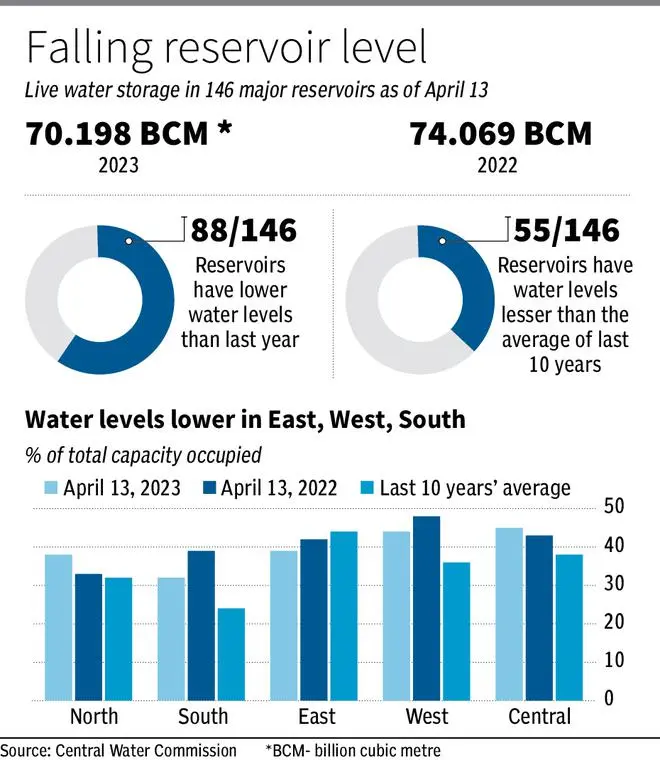A five percentage point drop in water storage level in the 146 major reservoirs across the country has now raised concerns over kharif crop prospects, apart from food security and inflation.
This comes amid a possibility of warm water phenomenon, El Nino, emerging during the South-West monsoon this year. It has cropped up on the heels of foodgrain stocks dropping to a six-year low as of April 1 and contradicting forecasts — from normal to deficient — of the monsoon.

The issue will likely attract the Centre’s attention with the country headed for Parliament elections next year. Experts, however, say there should be no cause for concern over food security since the Centre has been proactive in ensuring supply for the poor by banning wheat exports and curbing rice shipments last year.
Deficient rainfall
According to the Central Water Commission (CWC), the water storage position as of April 13 was 70.198 billion cubic metres (BCM) of the live storage capacity of 178.185 BCM. This is 95 per cent of last year’s storage of 74.069 BCM and 118 per cent of the last 10-year average.
The storage in eastern parts is lower than last year as well as the last 10-year average. In the southern and western parts, the level is lower than last year but higher than the last 10-year average; and higher than last year and the 10-year average in northern and central parts.
“The storage level is lower in eastern parts, particularly Bihar, as they experienced deficient rainfall during the south-west monsoon last year,” said S Chandrasekaran, a Delhi-based analyst who tracks agriculture across the country.
Monsoon forecast
The storage level raises concern over kharif crop prospects, which makes up 70 per cent of the country’s total agricultural production as private forecaster Skymet has forecast a deficient monsoon. The Indian Meteorological Department (IMD) has forecast a normal one, though.
Both agencies said El Nino, which results in drought in Asia and floods in the American continent, will likely develop during the monsoon period, probably after July. “We have factored in the possibility of El Nino impacting the monsoon,” said M Ravichandran, Secretary, Ministry of Earth Sciences, when IMD came out with its forecast last week.
Crops at stake
The IMD has projected below-normal rainfall in Haryana, Punjab, Rajasthan, Gujarat, Madhya Pradesh, Maharashtra and parts of the north-east. This puts crops such as paddy, oilseeds such as groundnut and soyabean and pulses — arhar/tur in particular — at stake.
Last year, rice production declined by 3 million tonnes (mt) to 108 mt due deficient rainfall in eastern parts. However, the shortfall was made up during rabi season with rice production now being estimated at a record 130.83 mt.
Data from the Food Corporation of India (FCI) show wheat stocks are currently at a six-year low of 8.35 mt compared with 18.99 mt a year ago. Rice stocks are also at a six-year low of 24.86 mt. In addition, the FCI has unmilled paddy stocks of 27.46 mt (18.38 mt of rice) — a 3-year low.
Chances of El Nino
Global agencies are divided over the development of El Nino. The Climate Research Centre of the US has predicted a 62 per cent chance of El Nino developing during May-July with a 40 per cent chance of a strong weather event. The Bureau of Meteorology, Australia, said there is a 50 per cent chance of an El Nino.
Chandrasekaran said the storage position should not be of concern in view of North India experiencing a heat wave currently. “We need to worry only if the water level falls to zero,” he said.

Tracing monsoon’s long range behaviour, he said rainfall deficiency during the south-west monsoon has never exceeded 20 per cent over the past two decades. “A 15-20 per cent deficiency is manageable. Also, 50 per cent of the cultivable lands get irrigation,” he said.
Chandrasekaran, a consultant with Agriculture and Commerce Ministries, said there should be no worry on the food front as the Centre has curbed shipments if there are any signs of trouble. With a ban on exports of wheat, its availability will be higher this year, he said.
This year, the Agriculture Ministry has estimated a record 112.18 mt of wheat production against 107.74 mt a year ago. However, heat in February and unseasonal rains in March are feared to lower the production. As of now, wheat procurement by the FCI is lower by 18 per cent but government officials are confident that they will achieve the target of 34.15 mt.



Comments
Comments have to be in English, and in full sentences. They cannot be abusive or personal. Please abide by our community guidelines for posting your comments.
We have migrated to a new commenting platform. If you are already a registered user of TheHindu Businessline and logged in, you may continue to engage with our articles. If you do not have an account please register and login to post comments. Users can access their older comments by logging into their accounts on Vuukle.